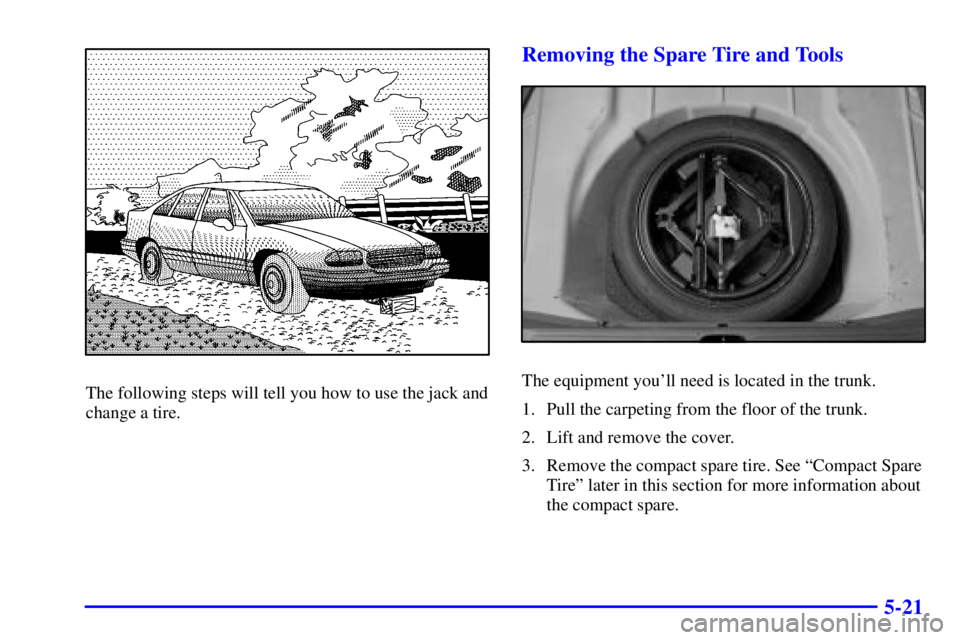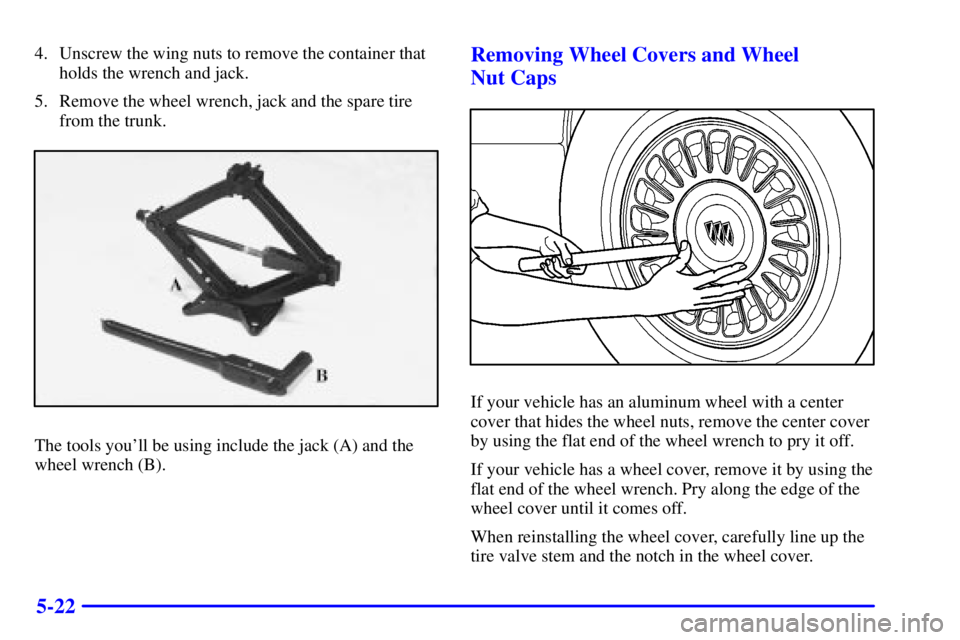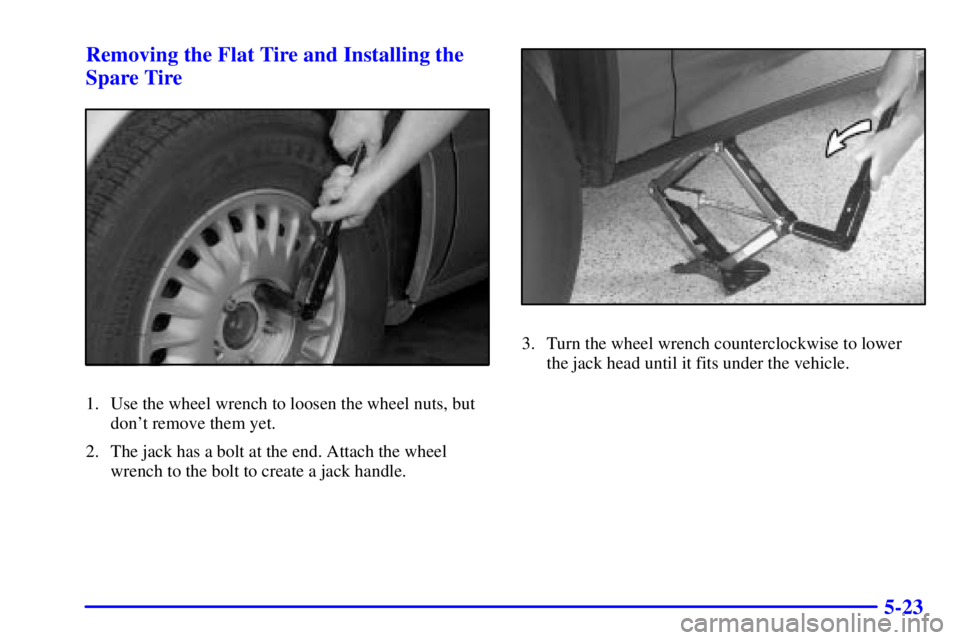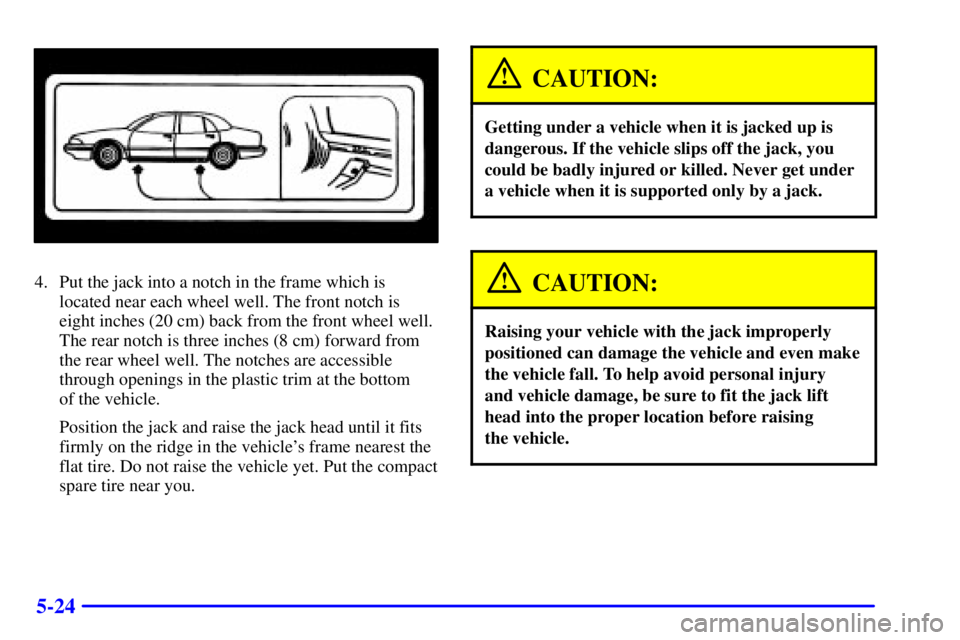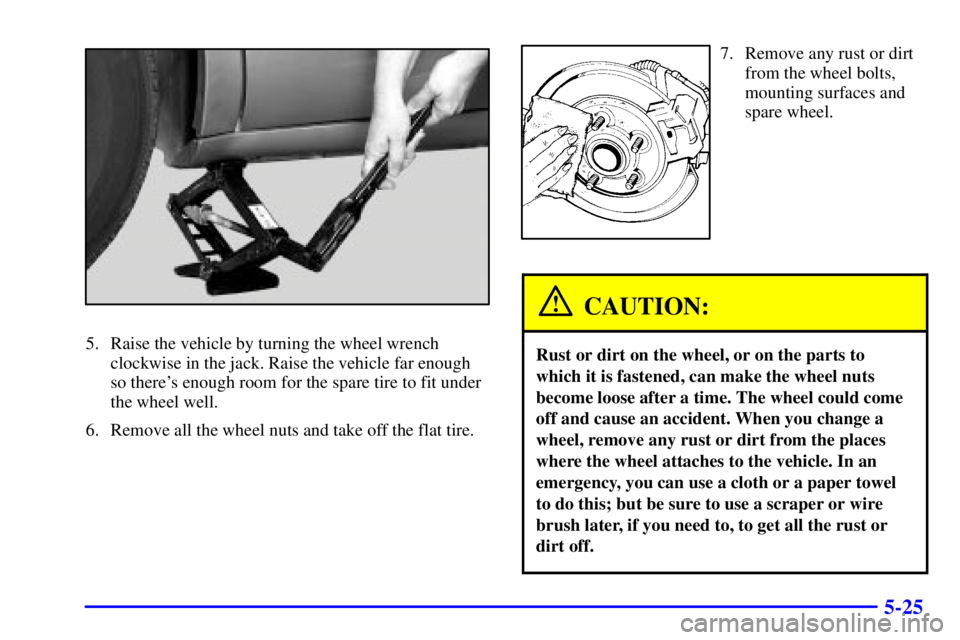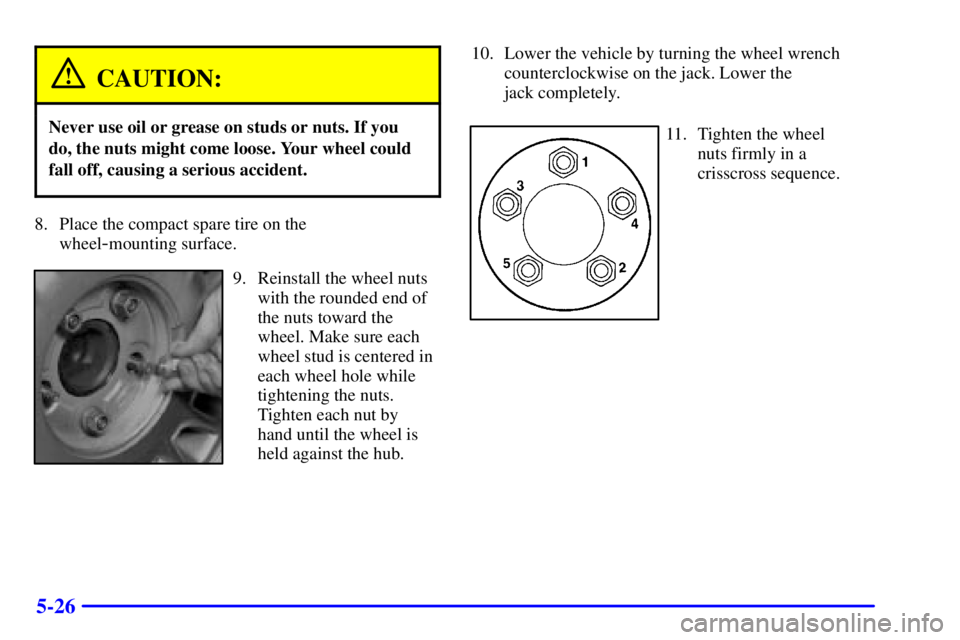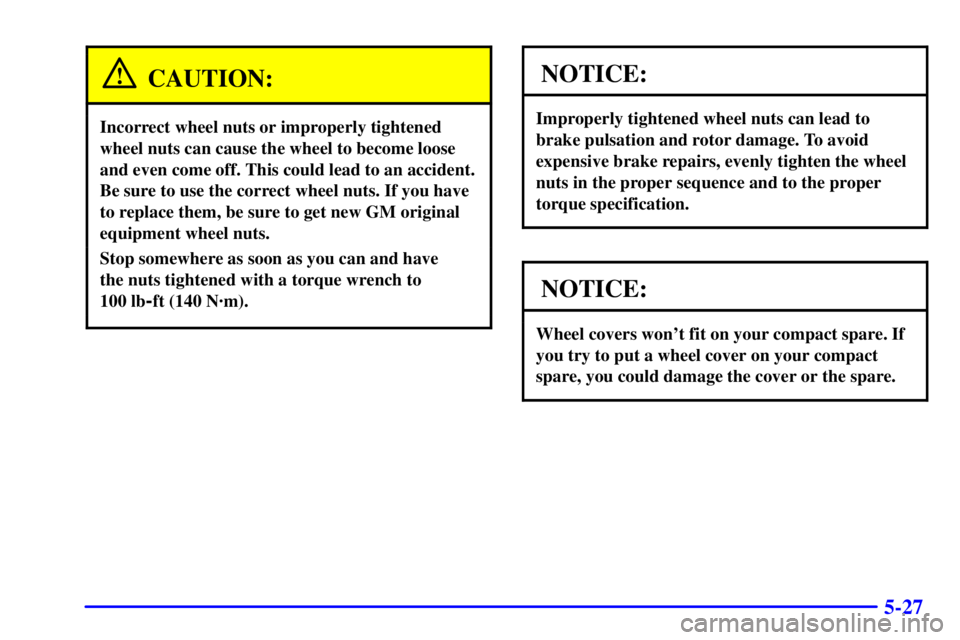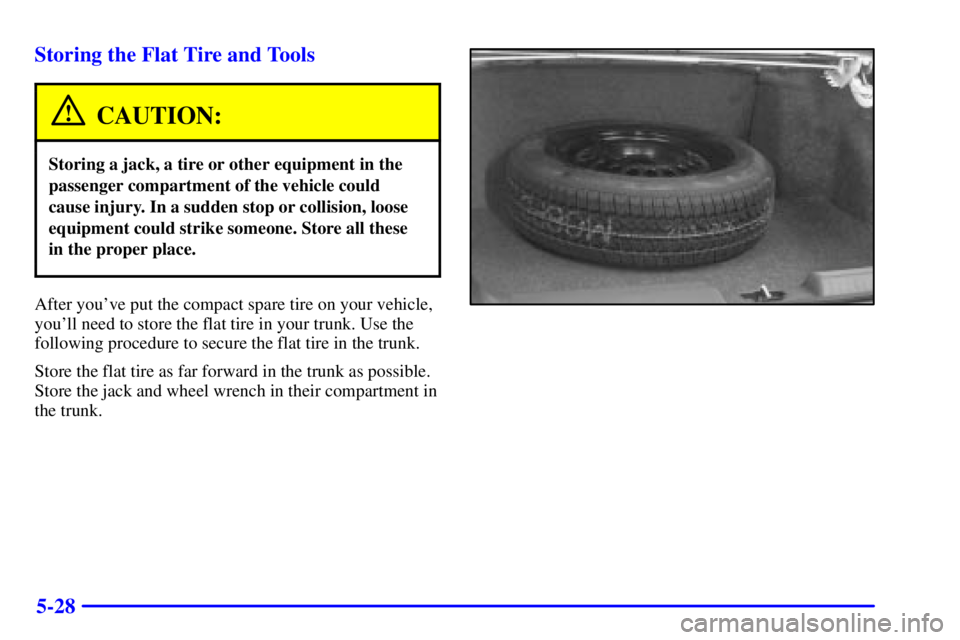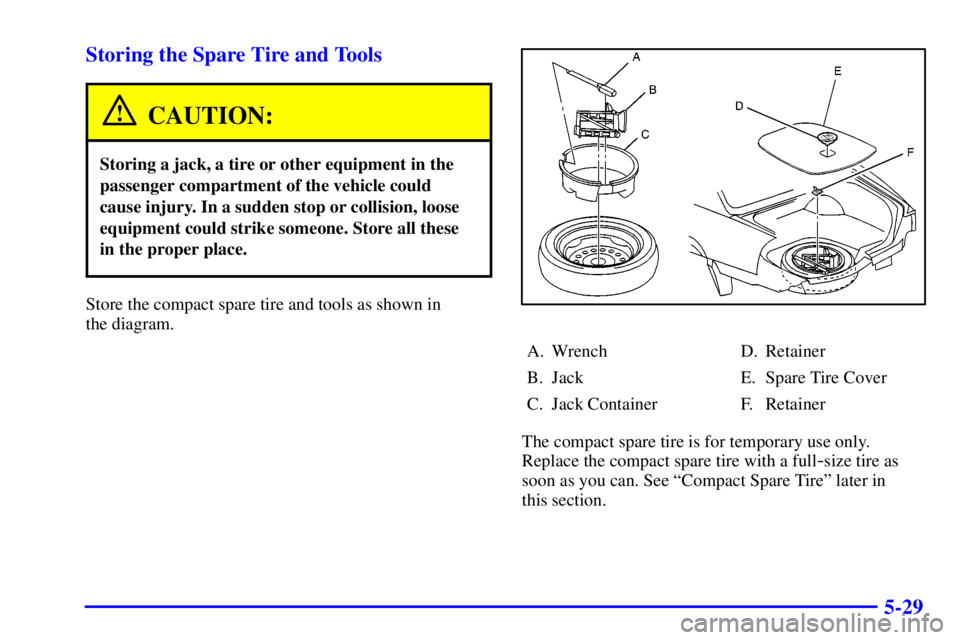BUICK LESABRE 2002 Owner's Manual
LESABRE 2002
BUICK
BUICK
https://www.carmanualsonline.info/img/43/35399/w960_35399-0.png
BUICK LESABRE 2002 Owner's Manual
Trending: height adjustment, glove box, door locks, oil additives, lights, alarm, 6-52
Page 261 of 398

5-20
If a Tire Goes Flat
It's unusual for a tire to ªblow outº while you're driving,
especially if you maintain your tires properly. If air goes
out of a tire, it's much more likely to leak out slowly.
But if you should ever have a ªblowout,º here are a
few tips about what to expect and what to do:
If a front tire fails, the flat tire will create a drag that
pulls the vehicle toward that side. Take your foot off
the accelerator pedal and grip the steering wheel firmly.
Steer to maintain lane position, and then gently brake
to a stop well out of the traffic lane.
A rear blowout, particularly on a curve, acts much like a
skid and may require the same correction you'd use in
a skid. In any rear blowout, remove your foot from
the accelerator pedal. Get the vehicle under control by
steering the way you want the vehicle to go. It may
be very bumpy and noisy, but you can still steer.
Gently brake to a stop
-- well off the road if possible.
If a tire goes flat, the next part shows how to use your
jacking equipment to change a flat tire safely.
Changing a Flat Tire
If a tire goes flat, avoid further tire and wheel damage
by driving slowly to a level place. Turn on your hazard
warning flashers.
CAUTION:
Changing a tire can cause an injury. The vehicle
can slip off the jack and roll over you or other
people. You and they could be badly injured.
Find a level place to change your tire. To help
prevent the vehicle from moving:
1. Set the parking brake firmly.
2. Put the shift lever in PARK (P).
3. Turn off the engine.
To be even more certain the vehicle won't move,
you can put blocks at the front and rear of the
tire farthest away from the one being changed.
That would be the tire on the other side of the
vehicle, at the opposite end.
Page 262 of 398
5-21
The following steps will tell you how to use the jack and
change a tire.
Removing the Spare Tire and Tools
The equipment you'll need is located in the trunk.
1. Pull the carpeting from the floor of the trunk.
2. Lift and remove the cover.
3. Remove the compact spare tire. See ªCompact Spare
Tireº later in this section for more information about
the compact spare.
Page 263 of 398
5-22
4. Unscrew the wing nuts to remove the container that
holds the wrench and jack.
5. Remove the wheel wrench, jack and the spare tire
from the trunk.
The tools you'll be using include the jack (A) and the
wheel wrench (B).
Removing Wheel Covers and Wheel
Nut Caps
If your vehicle has an aluminum wheel with a center
cover that hides the wheel nuts, remove the center cover
by using the flat end of the wheel wrench to pry it off.
If your vehicle has a wheel cover, remove it by using the
flat end of the wheel wrench. Pry along the edge of the
wheel cover until it comes off.
When reinstalling the wheel cover, carefully line up the
tire valve stem and the notch in the wheel cover.
Page 264 of 398
5-23 Removing the Flat Tire and Installing the
Spare Tire
1. Use the wheel wrench to loosen the wheel nuts, but
don't remove them yet.
2. The jack has a bolt at the end. Attach the wheel
wrench to the bolt to create a jack handle.
3. Turn the wheel wrench counterclockwise to lower
the jack head until it fits under the vehicle.
Page 265 of 398
5-24
4. Put the jack into a notch in the frame which is
located near each wheel well. The front notch is
eight inches (20 cm) back from the front wheel well.
The rear notch is three inches (8 cm) forward from
the rear wheel well. The notches are accessible
through openings in the plastic trim at the bottom
of the vehicle.
Position the jack and raise the jack head until it fits
firmly on the ridge in the vehicle's frame nearest the
flat tire. Do not raise the vehicle yet. Put the compact
spare tire near you.
CAUTION:
Getting under a vehicle when it is jacked up is
dangerous. If the vehicle slips off the jack, you
could be badly injured or killed. Never get under
a vehicle when it is supported only by a jack.
CAUTION:
Raising your vehicle with the jack improperly
positioned can damage the vehicle and even make
the vehicle fall. To help avoid personal injury
and vehicle damage, be sure to fit the jack lift
head into the proper location before raising
the vehicle.
Page 266 of 398
5-25
5. Raise the vehicle by turning the wheel wrench
clockwise in the jack. Raise the vehicle far enough
so there's enough room for the spare tire to fit under
the wheel well.
6. Remove all the wheel nuts and take off the flat tire.
7. Remove any rust or dirt
from the wheel bolts,
mounting surfaces and
spare wheel.
CAUTION:
Rust or dirt on the wheel, or on the parts to
which it is fastened, can make the wheel nuts
become loose after a time. The wheel could come
off and cause an accident. When you change a
wheel, remove any rust or dirt from the places
where the wheel attaches to the vehicle. In an
emergency, you can use a cloth or a paper towel
to do this; but be sure to use a scraper or wire
brush later, if you need to, to get all the rust or
dirt off.
Page 267 of 398
5-26
CAUTION:
Never use oil or grease on studs or nuts. If you
do, the nuts might come loose. Your wheel could
fall off, causing a serious accident.
8. Place the compact spare tire on the
wheel
-mounting surface.
9. Reinstall the wheel nuts
with the rounded end of
the nuts toward the
wheel. Make sure each
wheel stud is centered in
each wheel hole while
tightening the nuts.
Tighten each nut by
hand until the wheel is
held against the hub.10. Lower the vehicle by turning the wheel wrench
counterclockwise on the jack. Lower the
jack completely.
11. Tighten the wheel
nuts firmly in a
crisscross sequence.
Page 268 of 398
5-27
CAUTION:
Incorrect wheel nuts or improperly tightened
wheel nuts can cause the wheel to become loose
and even come off. This could lead to an accident.
Be sure to use the correct wheel nuts. If you have
to replace them, be sure to get new GM original
equipment wheel nuts.
Stop somewhere as soon as you can and have
the nuts tightened with a torque wrench to
100 lb
-ft (140 N´m).
NOTICE:
Improperly tightened wheel nuts can lead to
brake pulsation and rotor damage. To avoid
expensive brake repairs, evenly tighten the wheel
nuts in the proper sequence and to the proper
torque specification.
NOTICE:
Wheel covers won't fit on your compact spare. If
you try to put a wheel cover on your compact
spare, you could damage the cover or the spare.
Page 269 of 398
5-28 Storing the Flat Tire and Tools
CAUTION:
Storing a jack, a tire or other equipment in the
passenger compartment of the vehicle could
cause injury. In a sudden stop or collision, loose
equipment could strike someone. Store all these
in the proper place.
After you've put the compact spare tire on your vehicle,
you'll need to store the flat tire in your trunk. Use the
following procedure to secure the flat tire in the trunk.
Store the flat tire as far forward in the trunk as possible.
Store the jack and wheel wrench in their compartment in
the trunk.
Page 270 of 398
5-29 Storing the Spare Tire and Tools
CAUTION:
Storing a jack, a tire or other equipment in the
passenger compartment of the vehicle could
cause injury. In a sudden stop or collision, loose
equipment could strike someone. Store all these
in the proper place.
Store the compact spare tire and tools as shown in
the diagram.
A. Wrench
B. Jack
C. Jack ContainerD. Retainer
E. Spare Tire Cover
F. Retainer
The compact spare tire is for temporary use only.
Replace the compact spare tire with a full
-size tire as
soon as you can. See ªCompact Spare Tireº later in
this section.
Trending: turn signal bulb, fuel type, Sound system, oil change, turn signal, Driver information center, radio antenna

